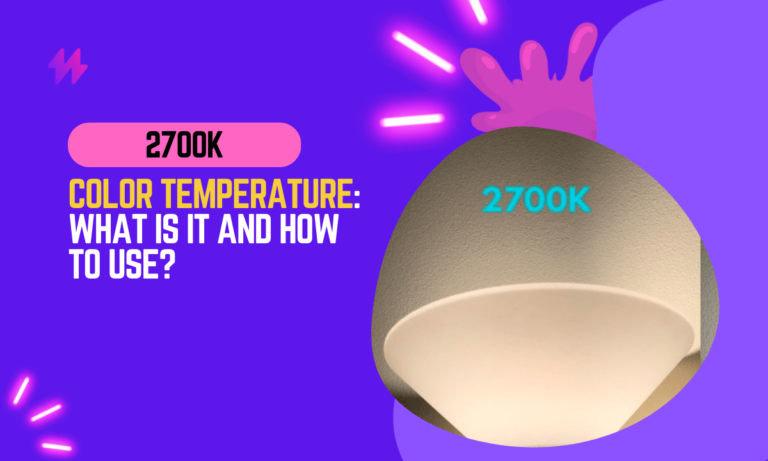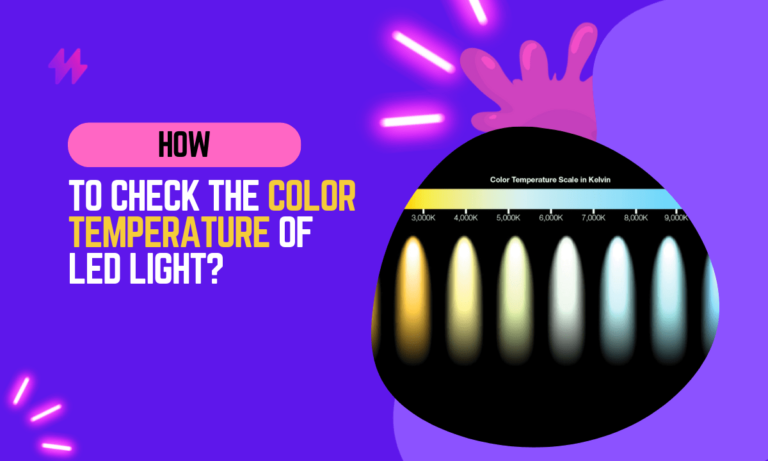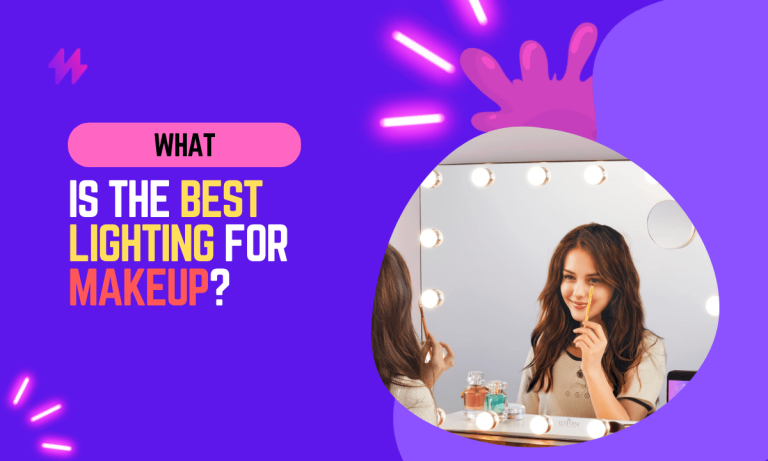2700K vs 3000K – How to Choose Lighting Color?
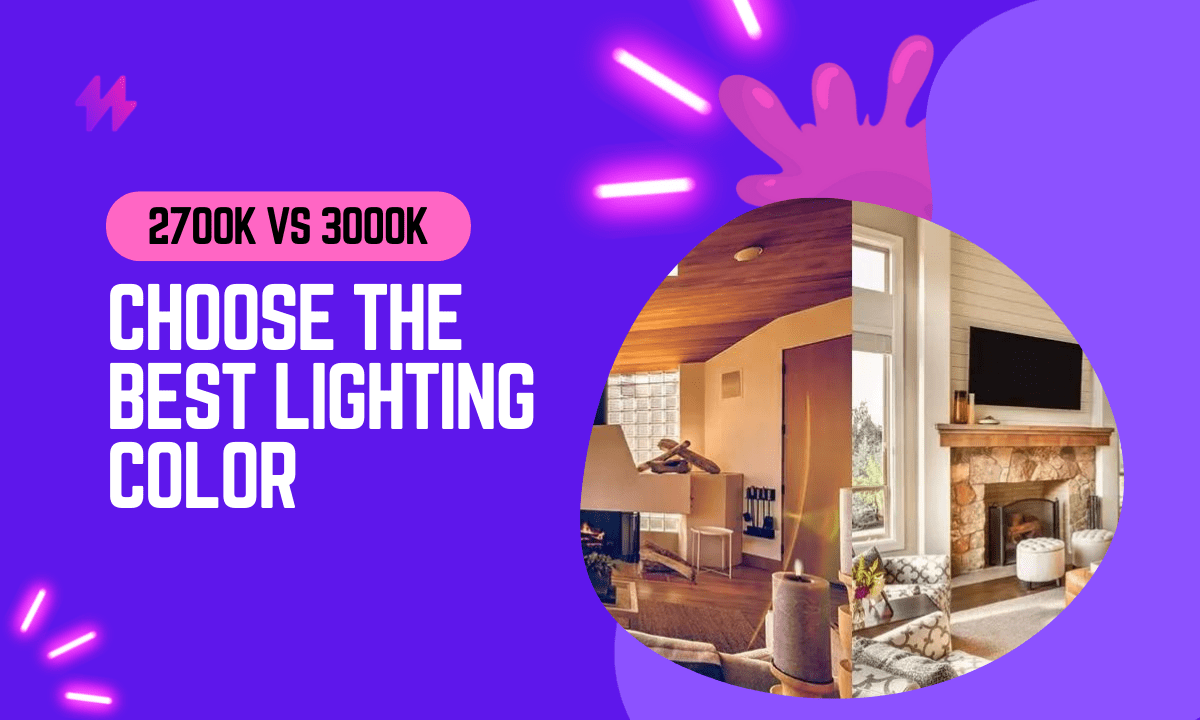
If you’re in the market for a new light bulb, you may have noticed that there are several different options available in terms of color temperatures. But what exactly is color temperature, and how does it affect the appearance of light?
In this blog post, we’ll delve into the differences between 2700K and 3000K light bulbs and explore their common uses and characteristics. Understanding the differences between 2700K and 3000K can help you make the right choice for your home or business.
Whether you’re looking to create a warm and cozy atmosphere or a bright and focused light, this post will provide all the information you need to make an informed decision.
When selecting between 2700K and 3000K light bulbs, it’s essential to consider your specific lighting needs and the atmosphere you wish to create in your space. Each color temperature offers unique properties, with 2700K typically providing warmer tones for a cozy glow and 3000K leaning towards a brighter illumination with a slightly whiter light. Understanding “2700K vs 3000K – how to choose lighting color” can greatly influence your choice of lamps and lighting solutions tailored to your home or workspace.
2700K vs 3000K – How to Choose Lighting Color for Your Needs: Understanding Lighting Design
The main difference between 2700K and 3000K is the hue of the light they produce. 2700K is warmer and more yellow, while 3000K is slightly cooler and more white.
Color temperature is a way to describe the hue of a particular type of light source, measured in degrees Kelvin (K). A lower color temperature corresponds to a warmer, more yellow hue, or orange hue, while a higher color temperature corresponds to a cooler, more blue light.
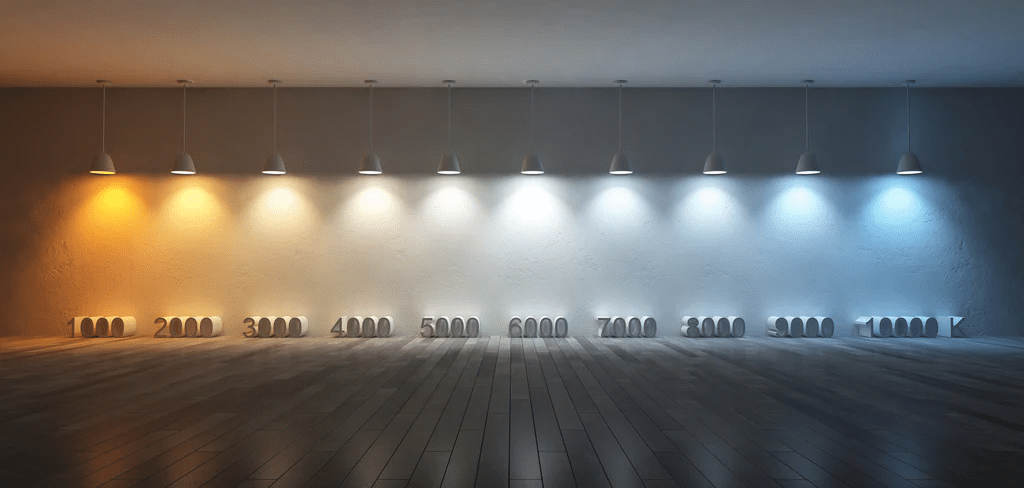
2700K is considered a warm white color temperature and is often used in residential and commercial settings to create a cozy, inviting atmosphere. It is often used in living rooms, bedrooms, and restaurants.
3000K is also considered a warm white color temperature, but it is slightly cooler than 2700K. It is often used in task lighting, such as in an office or workshop setting, where a brighter, more focused light is desired.
Choosing the right lighting can significantly impact the ambiance of a room, and understanding the differences in color temperature will help achieve the desired effect. When considering options for table lamps or ceiling lamps in a layered lighting design, you’ll want to ensure that the color and tone you receive from your bulbs offer the right brightness and warmth as per your task lighting needs.
Understanding Different Color Temperatures: Meeting Your Lighting Needs
There are many different lighting colors available, each with its own unique appearance and effect on a space. Some common lighting colors include:
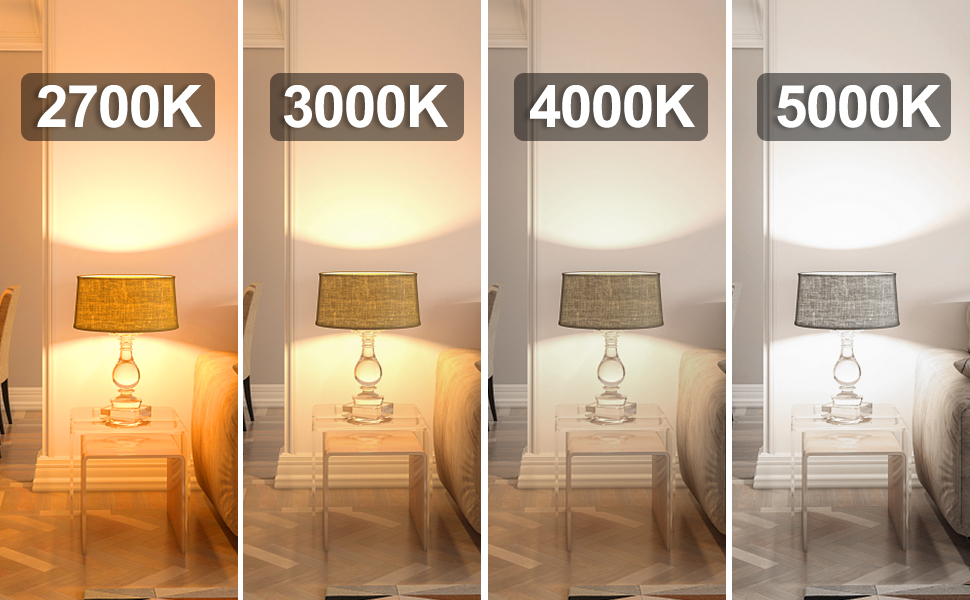
- 2700K: This color is often described as “warm white” and has a yellowish-orange hue. It is commonly used in living rooms, bedrooms, and other areas where a cozy and inviting atmosphere is desired.
- 3000K: This color is similar to 2700K but has a slightly cooler, more neutral appearance. It is often used in kitchens, bathrooms, and other areas where a brighter, more energizing light is desired.
- 4000K: This color is often referred to as “cool white” and has a bluish-white hue. It is commonly used in offices, hospitals, and other areas where a bright, crisp light is desired.
- 5000K: This color is known as “daylight” and has a bright, white appearance. It is often used in workshops, garages, and other areas where a high level of visibility is needed.
In general, warmer lighting colors (2700K and 3000K) can create cozy and ambient lighting, while cooler colors (4000K and 5000K) can provide a brighter, more energizing light. The right lighting color for a space will depend on the desired mood and ambiance, as well as the specific activities and tasks being performed in the space.
It’s important to note that the appearance of a lighting color can vary depending on the type of bulb or fixture being used. For example, an incandescent light bulb will have a different appearance than a LED bulb when both are set to the same color temperature.
Additionally, the effect of a lighting color on a space can also be influenced by other factors, such as the color of the walls and furnishings, the amount of natural light in the space, and the overall design of the space.
When choosing a lighting color, it’s important to consider all of these factors and how they will work together to create the desired atmosphere in a space. It may also be helpful to experiment with different colors and settings to find the right combination for your space.
When exploring various “lighting options,” it’s essential to think about how different “bulb types” can affect the overall ambiance of a room. For instance, using “led bulbs” or “incandescent bulbs” offers different warmth and brightness levels that can significantly impact the “color temperature” and “lighting controls” in your space.
2700K vs 3000K: Choosing the Right Light for Your Kitchen Lighting
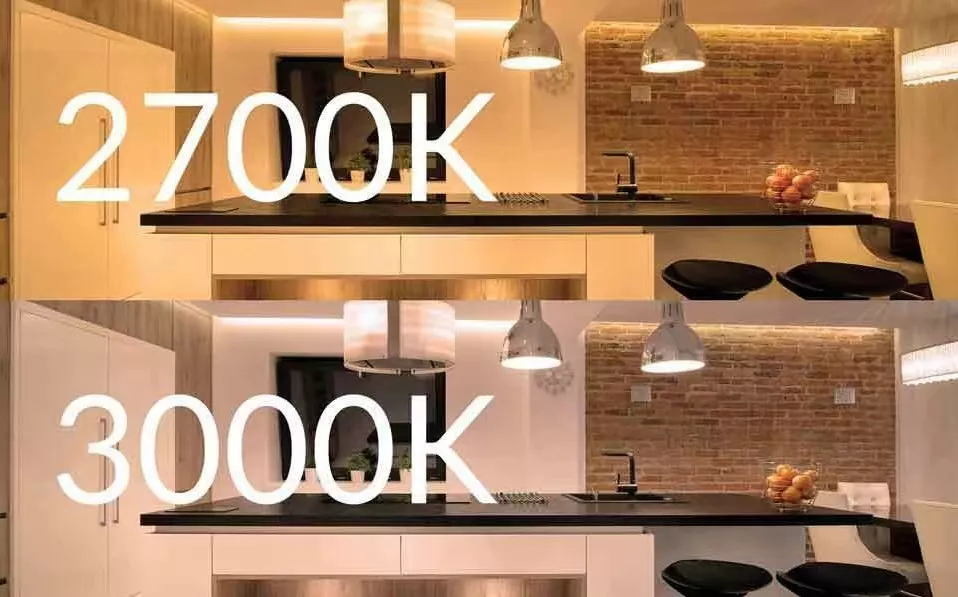
2700K light LED bulb produces a brighter, more focused light, while 3000K light bulbs produce a warmer, more comfortable light. When choosing between 2700k and 3000k LED light bulb for your kitchen, it’s important to consider what you’ll be using the lights for.
If you have a traditional-style kitchen with darker wood cabinetry, 3000K can be a great light color temperature. Warm white and Soft white can highlight wood grains and are recommended for earthy tones. 2700K and 3000K are primarily used in residential settings.
If you’ve got a more contemporary style kitchen with white cabinetry though, lean towards 3000K or even towards 4000K or 5000K. Warm light colors temperatures can potentially make white cabinets look pink and dull.
So, when choosing between 2700k and 3000k LED light bulbs for your kitchen, consider your kitchen’s style and what you’ll be using the lights for. If you have a traditional-style kitchen, 2700K LEDs may be the better choice. If you have a more contemporary style kitchen, 3000K LEDs would be the better option.
Learn more: How to choose LED light strip kit for Kitchen Cabinet Lighting
When selecting light bulbs for your kitchen, the choice between 2700K and 3000K can greatly influence the effectiveness of residential lighting. The warmer color spectrum of 2700K adds a cozy touch, while 3000K provides bright illumination and enhances color accuracy in more modern settings.
2700K vs 3000K: Choosing the Right Color Temperature for Bathroom Lighting
The ideal color temperature for a bathroom is between 3000K and 4000K. These can also be referred to as soft-white and cool-white. For most, a 2700K color temperature is just too yellow for a bathroom setting.
After all, we want bathrooms to appear bright, clean, and fresh. In order to achieve that feeling, it’s best to use a light with a bit more cool tones to it. 2700K light bulbs produce a warmer light, while 3000K light bulbs produce a cooler, more refreshing light.
If you’re looking for bathroom lighting that will make your space appear bright, clean, and fresh, then 3000K LEDs would be the better choice.
In addition to the essential factors mentioned, it’s also important to ensure that the selected bulbs—whether choosing between LED lights or traditional incandescent lighting—align with your bathroom’s overall design and usage. By opting for lights with improved color accuracy, you can enhance the space’s functionality and ensure that the hues of your decor and features are represented effectively.
2700K vs 3000K: Optimal Choices for Bedroom Lighting
The best color temperatures for a bedroom are 2000K and 2700K. This color temperature range produces a warm, inviting light that is perfect for relaxing. 3000K light bulb produces a cooler, more refreshing light that may be too harsh for a bedroom set.
If you’re looking for bedroom lighting that is warm and inviting, then 2700k LEDs would be the better choice.
Choosing the right light sources for your bedroom can dramatically influence its atmosphere, offering either a calming retreat or a more alert environment depending on the chosen color temperature. When focusing on warm lighting options, 2700K light bulbs deliver a soft light that enhances your room’s comfort, making it particularly suitable for night usage and relaxation.
2700K vs 3000K: Optimal Lighting Choices for Your Living Room
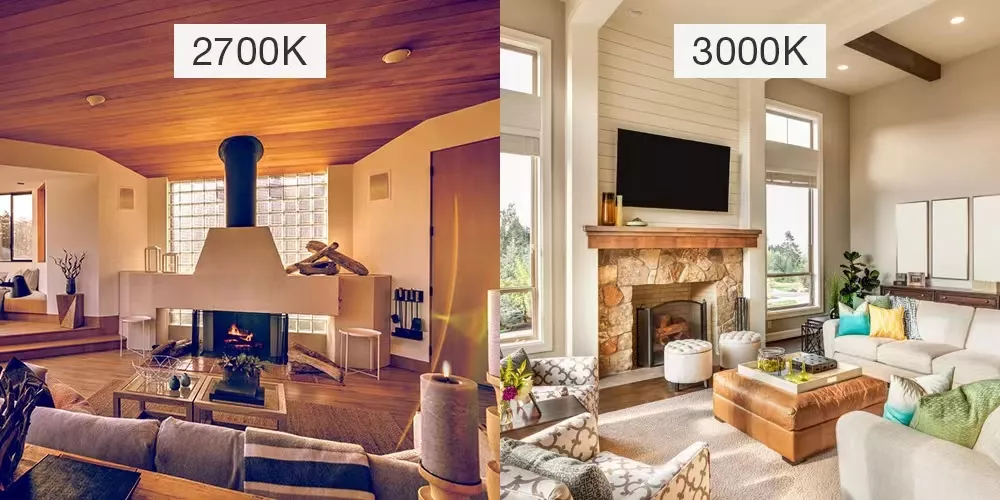
2700K and 3000K light bulbs produce a warm, inviting light that is perfect for relaxing in. If you’re looking for living room lighting that is warm and inviting, then 2700k or 3000k LEDs would be the better choice.
As 3000K, and especially 2700K, are better with earthy tones and wood grains, you’ll want to be ok with a warmer light color temperature. These two color temperatures work best in living rooms that are more traditional or transitional in style.
If you’ve got a more contemporary or modern living room, go with a cooler temperature of 3500K to 4800K (neutral white to cool white). That’s not to say a light fixture with a warm color temperature can’t be used in a contemporary setting and vice versa.
Truly, it comes down to personal preference and the mood that works best for you and your space.
Must read: 3 Factors to Avoid Color Temperature Inconsistencies
For a space designed with modern aesthetics, incorporating different bulbs can enhance the overall vibe. Utilizing dimmer switches with your incandescent light bulbs or fluorescent lamps will allow you to adjust the brightness and create the right atmosphere for both relaxation and productivity.
Final Thoughts on Lighting Choices: 2700K vs 3000K
In conclusion, the choice between 2700K and 3000K lighting colors is subtle yet significant, impacting the atmosphere and functionality of a space. Both color temperatures fall within the warm white spectrum, making them excellent choices for creating inviting and relaxing environments. The 2700K option emits a softer and warmer light, akin to the glow of an incandescent bulb. This warmth makes it particularly suitable for residential spaces such as living rooms, bedrooms, and dining areas where comfort and coziness are prioritized. The golden hue enhances the richness of wood furniture and other earth tones, making spaces feel welcoming and snug.
On the other hand, 3000K provides a slightly cooler, more neutral white light that bridges the gap between warm and stark white. This temperature is often preferred in areas where both relaxation and concentration are required, such as kitchens and bathrooms. It provides enough clarity for performing tasks effectively without sacrificing the welcoming quality of warm light. The 3000K setting is also beneficial in retail environments or showrooms where a slightly brighter ambiance can make merchandise appear more appealing without the harshness that higher color temperatures might impart. When selecting between 2700K and 3000K, consider the activities that will take place in the space, the natural light available, and the desired mood. Such considerations will ensure that the lighting enhances both the aesthetics and the functionality of the area, providing comfort and utility in equal measure.
2700K Vs 3000K – How To Choose Lighting Color | Comparing the Characteristics of 2700K and 3000K Lighting
Choosing between 2700K vs 3000K lighting color involves understanding the subtle nuances of warmth and ambiance that each temperature offers. The 2700K bulbs produce a warm glow reminiscent of traditional incandescent bulbs, providing a softer light with yellow tones that creates a cozy atmosphere, ideal for living rooms or bedrooms. On the other hand, 3000K lighting delivers a slightly brighter, more neutral light with minimal bluish tint, making it suitable for kitchens and workspaces where clarity and accuracy, especially in color rendering, are vital. Users can observe a color difference through a side-by-side comparison of these temperatures, noting how their respective light sources infuse spaces with varying warmth and brightness. High color rendering in 3000K options can enhance the visibility of bright colors in retail displays and art studios, while the softer light of 2700K can complement darker furniture. Each option serves distinct purposes, with energy-efficient CFL bulbs and dimmable options available in both color temperatures, providing flexibility for different lighting solutions across various room setups.
2700K vs 3000K – How to Choose Lighting Color | Warmth and Ambiance: What Each Temperature Offers
The warmth of lighting can significantly influence the ambiance of a space. At 2700K, lighting tends to emit a soft light that closely mimics the characteristics of traditional incandescent bulbs, providing a welcoming and cozy environment. This yellow/orange hue is ideal for spaces aimed at relaxation, such as living rooms or bedrooms, where a warm light output promotes comfort. Comparatively, 3000K lighting offers a brighter, whiter light that can enhance attention and focus while still providing a warm feel. This bluish light spectrum is perfect for areas like kitchens or workspaces, where a clear light is essential for task-oriented activities.
Choosing between the two color temperatures involves considering the intended use of the space. For instance, a desk lamp with a warm light output can help create an inviting atmosphere for reading or leisurely activities, while 3000K bulbs may be more suitable for retail displays, where accurate color representation and bright light are crucial. Understanding how light exposure affects color tones is vital, especially in areas with dark furniture or decor. By assessing the specific needs of each space and the effect of light temperature on color rendering, individuals can select the right light options to balance functionality and aesthetics effectively.
Brightness and Intensity: Understanding Light Output Differences
Understanding the differences in brightness and intensity between 2700K and 3000K lighting involves examining their visible light output and how they affect perceived brightness. While both temperatures can deliver comparable brightness levels, the light content they emit can create distinct atmospheres. For instance, 2700K offers a warm yellowish glow similar to standard incandescent bulbs, making spaces feel cozy. On the other hand, 3000K provides a subtler hue that leans towards a bluish-white glow, which can inject energy into a room. This variation in color and tone impacts how light falls across surfaces and can either amplify or soften the appearance of colors, especially for tasks like makeup application or setting mood lighting.
The spectral power distribution of these color temperatures plays a crucial role in the overall ambiance. For example, 2700K lighting solutions tend to produce soft light that reduces harsh glare, making it ideal for living spaces or bedrooms. In contrast, 3000K light tends to create a crisper light and is often used in work environments or retail displays, where ample daylight and clear color rendering are essential. Dimmable bulbs in both ranges enable users to adjust the intensity according to the functional needs of a space. Understanding these differences helps in selecting the right bulb types, whether opting for decorative bulb styles in a 6-lamp ceiling fan or brighter options for desk lamp fixtures, ensuring that the right color temperature aligns with the intended use.
Practical Applications of 2700K and 3000K Lighting
Choosing between 2700K vs 3000K involves understanding how each temperature applies to different environments and functions. The warmer lights of 2700K create a cozy atmosphere, ideal for living rooms and bedrooms where soft light is preferred. This color temperature produces a light emission reminiscent of traditional incandescent bulbs, offering a gentle glow that enhances the warmth of wood panels and plays nicely with makeup colors. On the other hand, 3000K strikes a balance, providing a crisp light that is bright enough for tasks in kitchens or garages, effectively illuminating spaces without the harsh glare associated with higher color temperatures. Each option has its advantages, with 2700K’s softer light helping to create an inviting ambiance, while 3000K’s clean aesthetics and energy efficiency make it a practical choice for areas that require full brightness. Understanding how to distribute lights and choosing the right light bulb side-by-side will help in creating the desired effect while minimizing dark spots and achieving the color distinction needed for various applications.
Best Uses for 2700K in Home Environments
2700K lighting is an excellent choice for creating a warm and inviting atmosphere in home environments. The soft light emitted closely mimics the incandescent bulb color, providing a subtle hue that enhances the comfort of spaces without inducing harsh glare. This temperature is particularly adept for living rooms and bedrooms, where a darkened room benefits from its warm hues. Compared to 3000K, which can introduce a blue-toned glow, 2700K strikes a balance that complements standard lamp fixtures and e12 lamp fixtures alike. This makes it suitable for both table lamps and decorative applications, ensuring a relaxed ambiance.
In spaces where individuals gather, such as dining areas, 2700K lighting plays a key role in ensuring that light levels are soft yet effective for interaction. The color temperature rating of 2700K falls within the color temperature spectrum that aligns well with traditional bulb types like incandescent and LED A19 bulbs. With the light spectrum exposure offering excellent color rendering, it allows for the true presentation of colors, making it ideal for personal and social settings. Whether using A21 lamps or MR16 style spotlights, the similarities in brightness and color tone you receive are commendable. This temperature delivers a comfortable light alternative that avoids the hard light associated with blue light spectrum elements found in higher color temperatures.
Ideal Scenarios for 3000K Lighting
3000K lighting is well-suited for areas where color accuracy is essential, such as retail displays. The color and tone you receive are similar to what an incandescent bulb delivers, making it an excellent choice for showcasing products. This high color temperature enhances colors by providing soft light that presents colors without the harsh glare that can occur with some other lighting options. Retail environments benefit from the ability of 3000K lights to infuse spaces with a warm yet vibrant feel, creating inviting displays that attract customers.
In practical settings, 3000K lighting works effectively in workspaces and kitchens, where a bright atmosphere is desirable. This lighting solution helps reduce eye strain, especially when paired with light-emitting screens, by offering a balance that enhances visibility without overwhelming glare. The slight shift from the warmer 2700K spectrum maintains a comfortable ambiance while improving focus and productivity. Using 4-ft fluorescent lamps or non-incandescent bulbs at this color temperature ensures energy efficiency, making it a popular choice for both residential and commercial applications.
How to Determine the Best Color Temperature for Your Space
Choosing the right color temperature for your space involves understanding the nuances between 2700K and 3000K lighting. These popular color temperatures greatly influence the atmosphere of a room, with 2700K providing a soft light that infuses spaces with warmth, while 3000K introduces a slightly cooler tone. This distinction can be crucial in various settings, such as retail displays where the color temperature affects how products appear under similar lighting styles. Halogen bulbs and old tube fluorescent lights often showcase different tones, impacting color rendering and glare. Consider how each temperature presents colors in your environment; for instance, 2700K lighting minimizes harsh glare, making it ideal for cozy settings. Balancing energy efficiency with aesthetic preference will guide your choices in light solutions that fulfill both functional and visual needs, ultimately helping to determine the best fit for your individual space.
Assessing Room Functionality and Mood
Choosing the appropriate color temperature significantly influences room functionality and mood. In the debate of 2700K vs 3000K – how to choose lighting color, understanding the impact of each option becomes essential. An environment lit with 2700K emits a warm, soft light that creates a cozy atmosphere, making it ideal for relaxing areas like living rooms and bedrooms. In contrast, 3000K offers a brighter light that can enhance focus, which is beneficial in workspaces or kitchens. Each option provides similar brightness levels while affecting how colors present themselves and reducing the risk of harsh glare.
Considering the function of a room involves recognizing how lighting infuses spaces with energy and emotion. Retail displays benefit from 3000K lighting, as it improves color rendering and draws attention to products without creating a light hazard. On the other hand, soft light offered by 2700K lighting minimizes visual fatigue, perfect for areas designed for leisure and relaxation. As individual bulbs fall in and out of favor, it’s crucial to assess how the chosen lighting strikes a balance between aesthetic appeal and energy efficiency.
Considering Personal Preferences and Lighting Effects
Personal preferences play a significant role in choosing between 2700K vs 3000K – how to choose lighting color based on individual tastes. Some individuals prefer the soft light that 2700K offers, creating a cozy and inviting atmosphere that enhances personal spaces. On the other hand, 3000K lighting provides a brighter, more energetic feel, ideal for areas that require focus and alertness. Selecting the right color temperature can also influence how present colors appear in a room, impacting activities that rely on accurate color rendering without harsh glare.
Light effects are equally important to consider. The degree of energy efficiency in lighting impacts decisions, especially in retail displays. High-quality lights infuse spaces with a sense of vitality, while poor lighting can create uncomfortable glare. Understanding the differences between 2700K and 3000K can enhance the mood of a room, ensuring that both functionality and aesthetics meet user expectations. Choosing the right lighting color temperature ultimately revolves around personal preferences and the desired ambiance for any space.
Making the Transition: Switching Between 2700K and 3000K
Transitioning between 2700K and 3000K lighting can significantly affect the ambiance of a space. Understanding the nuances of 2700K vs 3000K – How to Choose Lighting Color is key to ensuring a smooth shift. The warm, soft light offered by 2700K is ideal for cozy environments, making it perfect for homes. In contrast, 3000K provides a brighter, yet still warm option suitable for areas that require more clarity without harsh glare. Color temperature refers to how warm or cool a light appears, which is crucial in settings like retail displays, where energy efficiency and effective color rendering can enhance product visibility. By thoughtfully integrating these two color temperatures, one can create a harmonious environment that meets both aesthetic and functional needs.
Tips for Gradual Changes in Lighting
Gradually transitioning from 2700K to 3000K or vice versa can enhance the comfort and functionality of your space. Begin by introducing light fixtures that offer dimming capabilities. This flexibility allows you to adjust the intensity and warmth of the light, helping to minimize harsh glare and improve color rendering. Consider personalizing the lighting to suit different areas, especially in retail displays where energy efficiency is crucial. A balanced mix of 2700K and 3000K can create a welcoming atmosphere, blending the soft light offers of the warmer tone with the more invigorating qualities of cooler light.
Experimenting with light placement can also facilitate a smoother transition between these color temperatures. For example, placing 2700K lighting in areas meant for relaxation, like living rooms or bedrooms, can help maintain a cozy ambiance. Conversely, using 3000K in task-oriented spaces, such as kitchens or home offices, can enhance focus and productivity. By thoughtfully choosing where to install each temperature, you can achieve the desired effect without overwhelming your space. This gradual shift aligns with the principles of 2700K vs 3000K – How to Choose Lighting Color, allowing for a cohesive and adaptable lighting strategy.
Integrating Different Color Temperatures in Your Home
Creating a cohesive lighting scheme in your home involves the thoughtful blending of 2700K and 3000K lighting. Each temperature serves distinct purposes, with 2700K providing a soft, inviting glow ideal for relaxation areas. On the other hand, 3000K lighting can enhance focus and clarity in workspace settings. Understanding the differences in the 2700K vs 3000K – how to choose lighting color can guide decisions for ambient versus task lighting.
Incorporating both color temperatures allows for unique effects tailored to specific areas of the home. For instance, combining 2700K lighting in living rooms with 3000K lights in kitchens can balance warmth with practicality. This blend can also reduce harsh glare.color rendering while maintaining energy efficiency. These choices are essential, especially in retail displays.energy, where proper lighting impacts product visibility and customer experience.

